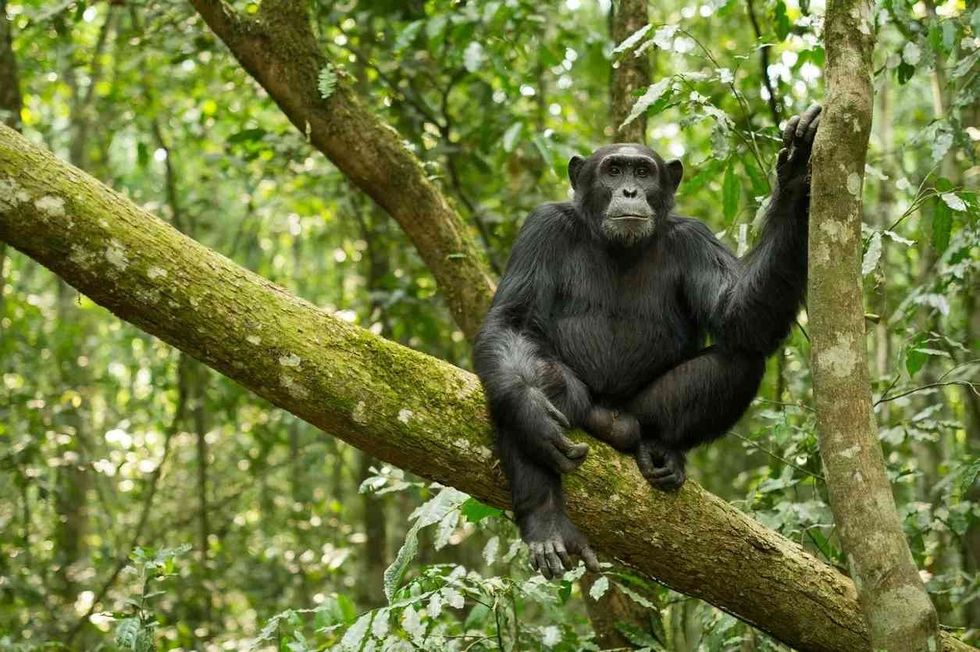Chimpanzees, more commonly known as chimps are classified in the genus Pan. The species have become endangered and are found mainly in the tropical forest and grasslands of West Africa or Central Africa. Humans and chimpanzees are known to have common ancestors.
They also have similar facial expressions. On average, chimpanzees live for around 33 years.
However, the oldest recorded age of a chimpanzee was of a female chimp called Little Mamma. She lived for 76-82 years. However, the average lifespan of female chimpanzees is more than that of male chimpanzees.
Chimpanzees, scientifically known as Pan troglodytes, usually do knuckle walking but they can also walk upright on two legs. Chimps and bonobos are also the closest living relatives of humans.
Wild chimpanzees feed on fruits, nuts, insects, meat, and eggs. At times, chimps use honey, leaves, or flowers to fill their stomach. Adult female chimps get impregnated every three to four years and give birth after a gestation period of around eight months.
Chimps live in hierarchical communities with the alpha male being at the top. Other males of the community rank after the alpha male and then comes the females of the community. Females are ranked at the lowest rung of the community.
Chimps can also use tools as they have opposable thumbs and a firm grip similar to humans. They use tools like stems, branches, leaves, and twigs. Chimps use such tools for cleaning themselves, feeding, and drinking. Some also use tools to dig into ant nests. Tool use is taught to baby chimps by their mothers.
If you like this article on common chimpanzee facts and information, then also check out, pygmy marmoset and capuchin monkeys.
Chimpanzee Interesting Facts
What type of animal is a chimpanzee?
Chimpanzees or chimpanzees (Pan troglodyte)s are great apes with which humans share 98.7 percent in their genetic blueprint. They are animals that human beings are closely related to and are known to have many human-like features.
What class of animal does a chimpanzee belong to?
Similar to human being, a chimp also belongs to the Mammalia class of animals. The chimpanzee scientific name is pan troglodytes.
How many chimpanzees are there in the world?
Great ape chimps are listed as endangered species on the International Union for Conservation of Nature Red List of Threatened Species. The number estimated to be remaining in the wild is between 170,000 and 300,000.
Where does a chimpanzee live?
Groups of chimpanzees live in the tropical forest and Savanna in Africa. The regions between Senegal in the west and Lake Albert and the north-western regions of Tanzania in the east are inhabited by these great apes. They usually spend most of their time on treetops.
What is a chimpanzee's habitat?
Chimpanzee groups are highly adaptable and can live in different habitats like tropical rainforests, swamp forests, savannah, and montane rainforests from sea level to about 3000 m in elevation. They inhabit both dry savannah and less dense savannah. The chimpanzee habitat is located in African countries like Sierra Leone, Tanzania, the Democratic Republic of Congo, and Angola.
Who do chimpanzees live with?
A chimpanzee is a very social animal similar to a human being. They live in groups or communities consisting of fusion-fission societies.
The groups or communities have a specific home range guided by a dominant male, called an alpha male. All communities consist of around 15-80 individuals including males, females, and babies. Some individuals have authority over others in all communities making their societies hierarchical in nature.
How long does a chimpanzee live?
The average chimpanzee lifespan of a male is around 39 years while the average lifespan of females is 32 years. However, the oldest age ever of a chimpanzee to have been recorded was 76-82 years.
How do they reproduce?
Males and females amongst chimpanzees mate all year round. A female chimpanzee tends to mate with several males in the community. Females are mated by almost all males in the community.
Females give birth to babies every three to four years and have a cycle very similar to humans. They come into oestrus every 36 days and have the tendency to become pregnant at that time.
The gestation period is of eight months (202-261 days). After the baby is born, the mother takes care of the baby and carries the baby with her everywhere she goes for around six months. Babies remain dependent on mothers for a long period, sometimes going up to 10 years.
What is their conservation status?
Chimpanzees have become endangered. They have already become extinct from four African nations. IUCN has noted that the populations of chimpanzees have fallen since the 1980s. The reason for their disappearance is habitat loss due to deforestation for the expansion of farming lands, poaching, and diseases. Other animals like leopards and lions also hunt chimpanzees.
Chimpanzee Fun Facts
What do chimpanzees look like?

A chimpanzee has a flat face like human beings. They have white skin covered with black hair. However, chimpanzee hands, feet, face, and ears are black.
A chimpanzee face has a white beard and a small nose. The small noses indicate that they depend more on the sense of sight as humans do. Their arms are longer than their feet.
They walk using the soles of their feet and the knuckles of their hands. However, they are also capable of walking upright on their feet. They have opposable thumbs and a firm grip that helps them hold onto branches and other things.
How cute are they?
Baby chimps are very cute, affectionate, and needy. However, chimps become aggressive and huge as they grow up.
How do they communicate?
Chimpanzees communicate through various different vocalizations. However, the most common one is a pant hoot. It is a loud long distance call used by the chimps to inform their community members about anything or to stay connected with them. There are around 30 different vocalizations used by the chimps to communicate with their fellows.
How big is a chimpanzee?
Chimpanzees are huge animals, much bigger in size than monkeys. A male adult chimpanzee weighs around 40-70 kg on average while an adult male mandrill (the largest of the old world monkeys) weighs somewhere between 32-54 kg (70- 119 lb).
The difference between the weights of the female chimp and mandrill is more significant. A female chimp weighs around 27-50 kg while the average weight of a female mandrill is 12 kg (27 lb).
The average height of a standing male chimpanzee is 150 cm while that of a male mandrill ranges from 75-95 cm. This comparison shows that chimpanzees are comparatively bigger than the biggest in the species of monkeys.
However, talking about gorillas, it should be noted that chimpanzees are much smaller than gorillas. Gorillas weigh around 150-160 kg on average which is almost double the weight of a chimpanzee.
How fast can a chimpanzee run?
Chimpanzees are fast runners even though they are huge animals. They can reach a speed of 25 mph while running. They are much stronger and sometimes even faster than human beings.
How much does a chimpanzee weigh?
Adult male Chimpanzee pan troglodytes weigh somewhere between 40-70 kg, that is 88- 154 lb. On the other hand, adult females weigh around 27-50 kg, that is 60-110 lb. Chimps are larger and more robust than their close relatives, bonobos.
What are their male and female names of the species?
Male chimpanzees are known by the name of blackbuck while females chimpanzees are known as empress.
What would you call a baby chimpanzee?
If you're searching for a baby name to complete your baby chimpanzee facts, we're about to burst your bubble. A baby chimpanzee does not have any distinct or specific name so they are generally called infant chimpanzees or baby chimpanzees only.
What do they eat?
Chimpanzee (Pan troglodytes) eat a wide range of food options available to them. They are omnivores so they feed on plants as well as meat.
Almost half of the chimpanzee diet comprises of the great source of energy that is figs. Another major component of their diet is a range of fruits including bananas, mangoes, watermelons, and apples.
During seasons of short supply of fruits in the wild, chimps feed on leaves, flowers, or tree barks. They also feed on nuts and seeds like oil palm nut, kola nut, or panda nuts.
Around 4% of a wild chimps’ diet is made up of insects. They use tools to dig ants and eat them. Another major component of their diet is honey that is also accessed by using sticks.
Chimpanzees also hunt and eat meat. Research shows that chimpanzees are also aware of the nutritional values of some wild plants and thus include them in their diet. The chimpanzee strength and chimpanzee muscle can be credited to their diet.
Are they loud?
The chimpanzee is known to be a very loud animal. They are noisy and usually scream, hoot, and whimp. Mostly adult males are aggressive and make aggressive sounds by screaming and hooting.
Chimps also produce loud long-distance vocalizations called pant- hoot. High ranking male chimps are known to emit these sounds more often and frequently. Pant hoots are used by chimps to indicate different things.
Would they make a good pet?
They would not make good pets due to a number of reasons. They are wild animals who are undomesticated and wary of human contact, thus cannot be kept at home or in a human community.
They learn life skills from their mothers and by living in their community. However, if they are to be kept as pets, they will have to be dissociated from their community at a very young age.
An adult chimpanzee is five to six times more powerful than a human so it can be said that even adult humans will be incapable of handling a mature chimpanzee or defending themselves against a chimpanzee attack.
They are also very aggressive and loud animals. Thus, it can be said that a chimpanzee does not have any qualities that would make it a good pet chimpanzee.
Did you know...
Studies and researches have been conducted to find out if human sperm can fertilize with a chimpanzee egg. But these attempts failed so the conclusion is that humans sperm cannot fertilize chimpanzee eggs.
Are chimpanzees dangerous?
Chimpanzees are extremely dangerous. By the age of five, they become stronger than most human adults. By that age, they become destructive and can even kill humans. They can attack anyone. However, they avoid killing a chimpanzee of their own community.
Chimpanzee vs. gorilla
Chimpanzees and gorillas are closely related but have a number of differences between them. Here is a breakdown of the gorilla versus chimpanzee comparison.
Both of them are also related to humans and as per reports chimpanzees, bonobos, gorillas, and humans shared a common ancestor within the last 11 million years. However, gorillas are much more dangerous than chimpanzees. They are far stronger and huge and also have bigger and better teeth than chimpanzees.
However, chimpanzees are considered to be more aggressive than a gorilla. Gorillas are gentle while chimps can even kill their community members and humans too.
If competing against each other, a gorilla can kill a chimpanzee with its better teeth and strength. Another point of difference between the two animals is their social formation.
While chimpanzees live in temporary social settings, changing their social communities often, gorillas live in permanent social groups. Talking about the nests, chimps tend to live on treetops while gorillas are more often found living on the ground.
Here at Kidadl, we have carefully created lots of interesting family-friendly animal facts for everyone to discover! Learn more about some other mammals including ring-tailed lemur, or plains zebra.
You can even occupy yourself at home by drawing one on our chimpanzee coloring pages.










